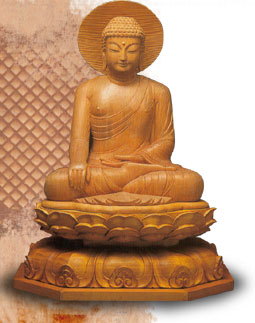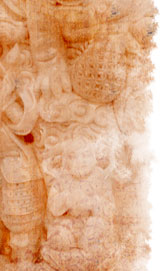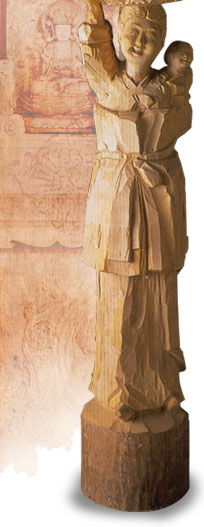The Buddhist statues of Park Chan-soo are objects of religious worship more than anything else, and that is why they
exhibit transcendental beauty beyond what any simple work of art can attain. His creations are based on his profound
understanding of Buddhist doctrines and scriptures as well as his mastery of the traditional methods of expression
for each image he captures. His Buddhist statues clearly show not only his vast knowledge and experience (in terms
 of both science and aestheticism) of the Buddhist images, but that he comes as close as possible to the religious state of both science and aestheticism) of the Buddhist images, but that he comes as close as possible to the religious state
 the creator of the original work felt, and assimilates himself with it. The process of choosing the right wood for each the creator of the original work felt, and assimilates himself with it. The process of choosing the right wood for each
 Buddhist statue, getting the accurate measurements for the precise proportion and balance, and mastering the original
Buddhist statue, getting the accurate measurements for the precise proportion and balance, and mastering the original
 method of expression is as difficult and as all-consuming as sculpting the wood. Yet a masterpiece that demands time,
method of expression is as difficult and as all-consuming as sculpting the wood. Yet a masterpiece that demands time,
 effort, passion and trust in order for it to be complete has its own reason of being; therefore, it is not a copy but
effort, passion and trust in order for it to be complete has its own reason of being; therefore, it is not a copy but
 an original and earns a new existence as an important cultural property of our time. His
an original and earns a new existence as an important cultural property of our time. His
 Buddhist statues have the power to make us imagine what the original masters’
Buddhist statues have the power to make us imagine what the original masters’
 religious and artistic motivations were. Thus, to say that he is a true descendent
religious and artistic motivations were. Thus, to say that he is a true descendent
 of the ancient master wood sculptors is far from an exaggeration.
of the ancient master wood sculptors is far from an exaggeration.
 Another attraction of Park’s Buddhist statues is the colors he revived from the Another attraction of Park’s Buddhist statues is the colors he revived from the
 Goryeo Dynasty tradition. These five ‘cardinal colors:’ red, yellow, blue, green
Goryeo Dynasty tradition. These five ‘cardinal colors:’ red, yellow, blue, green
 and black, highlight the natural texture and grain of the wood and produce
and black, highlight the natural texture and grain of the wood and produce
an astonishingly serene and elegant atmosphere. The application of such colors in
modern times creates the same calming effect as they did long ago, and its peaceful
aura never tires the eyes. The natural shading of the watercolors helps to increase
the three-dimensional effect of the object and heightens the symbolism of the
religious icon. When the brilliant colors are blended with traditional patterns and
designs, the Buddhist statues seem to appear as a manifestation of divinity,
whether it is an ancient relic or not.
Park Chan-soo does not choose to only preserve tradition, but continues to
re-create it according to his own sense of beauty. His invention of new carving
techniques, such as the ‘hemp cloth cutting’ technique used to create the texture
of hemp cloth on the surface of the wood, and the ‘wave cutting’ technique by
which the wood surface is finished with wave forms, also demonstrates his
commitment to finding new artistic evolutions and revelations instead of
comfortably reproducing tradition.
 Two terms, divine unity ('sinmyeong') and innocence ('cheonjin'), are often cited to define the world of Park’s art. Two terms, divine unity ('sinmyeong') and innocence ('cheonjin'), are often cited to define the world of Park’s art.
 When he sculpts a piece of wood in his workshop, even a casual visitor can sense the holy harmony taking place
When he sculpts a piece of wood in his workshop, even a casual visitor can sense the holy harmony taking place
 between the artist and his medium as he breathes new life into it. Meanwhile, the theme of innocence is best
between the artist and his medium as he breathes new life into it. Meanwhile, the theme of innocence is best
 represented by the images of a child seeker (above), Park’s favorite subject. Their essence is calmness and
represented by the images of a child seeker (above), Park’s favorite subject. Their essence is calmness and
 meditation, yet the carefree postures of the child monks bring warm smiles to viewers’ faces. The secret behind
meditation, yet the carefree postures of the child monks bring warm smiles to viewers’ faces. The secret behind
 the comfort and serenity we feel from these works of art lies in the artist’s gift to experience the tender, all-forgiving
the comfort and serenity we feel from these works of art lies in the artist’s gift to experience the tender, all-forgiving
 gentleness of the wood and to respect its compassionate nature in order to reveal his artistic aspirations of
gentleness of the wood and to respect its compassionate nature in order to reveal his artistic aspirations of
 sinmyeong and cheonjin.
sinmyeong and cheonjin.
 Compared with other materials that are non-living, an artist can only create a splendid wooden art form if Compared with other materials that are non-living, an artist can only create a splendid wooden art form if
 he or she respects it as living thing. Because of Park’s reverence for wood, he has been able to revive the tradition
he or she respects it as living thing. Because of Park’s reverence for wood, he has been able to revive the tradition
 as well as attain a unique position and title in the art of woodcarving. Like Michelangelo who had the gift to liberate
as well as attain a unique position and title in the art of woodcarving. Like Michelangelo who had the gift to liberate
 a form from stone, Park Chan-soo can bestow new life to wood that was once rooted in the earth. His process
a form from stone, Park Chan-soo can bestow new life to wood that was once rooted in the earth. His process
 of creation upholds a religious solemnity; he kneels in prayer before a tree prior to cutting it, and decides the
of creation upholds a religious solemnity; he kneels in prayer before a tree prior to cutting it, and decides the
 course of action according to the tree’s species, its condition of growth and the environment. This is necessary
course of action according to the tree’s species, its condition of growth and the environment. This is necessary
 because two trees of the same species can differ greatly from each other in terms of solidness, pattern and color.
because two trees of the same species can differ greatly from each other in terms of solidness, pattern and color.
 In order to make a Buddhist statue, for example, the artist must be careful to match the head (which is actually the
In order to make a Buddhist statue, for example, the artist must be careful to match the head (which is actually the
 roots) of a tree with the head of the image; thus, he is making a tree stand upside down, but by doing this the image
roots) of a tree with the head of the image; thus, he is making a tree stand upside down, but by doing this the image
 can last longer without cracking. This incredible fact reveals that a carver must have comprehensive knowledge
can last longer without cracking. This incredible fact reveals that a carver must have comprehensive knowledge
 of wood in order to become one with it.
of wood in order to become one with it.
 Park Chan-soo says that when he gazes at a piece of wood he will carve, he feels that it whispers to him what it Park Chan-soo says that when he gazes at a piece of wood he will carve, he feels that it whispers to him what it
 wants to be. He says that every piece of wood has a dream of reincarnating into another form according to its nature.
wants to be. He says that every piece of wood has a dream of reincarnating into another form according to its nature.
 When he breathes the spirit of his artist’s soul into the essence of the wood, it is reborn into the form it dreamed of
When he breathes the spirit of his artist’s soul into the essence of the wood, it is reborn into the form it dreamed of
 and begins a new life. Thus, Master Wood Sculptor Park Chan-soo has the exceptional ability to dream the dreams
and begins a new life. Thus, Master Wood Sculptor Park Chan-soo has the exceptional ability to dream the dreams
 of wood, and recreate wonders of nature into exquisitely beautiful works of art.
of wood, and recreate wonders of nature into exquisitely beautiful works of art.
View the master's works
|






















